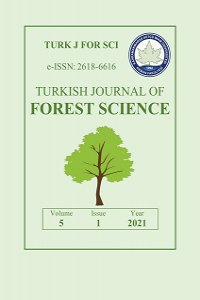RAPIDEYE UYDU GÖRÜNTÜSÜ İLE PİKSEL TABANLI VE OBJE TABANLI SINIFLANDIRMALARIN KARŞILAŞTIRILMASI
Piksel-tabanlı sınıflandırma, Obje-tabanlı sınıflandırma, RapidEye, AKAÖ
COMPARISON OF PIXEL AND OBJECT BASED CLASSIFICATION METHODS ON RAPIDEYE SATELLITE IMAGE
Pixel-based classification, Object-based classification, RapidEye, LULC,
___
- Anderson, J.R., Hardy, E.E., Roach, J.T., & Witmer, R.E. (1976), A Land Use and Land Cover Classification System for Use with Remote Sensor Data, Geological Survey Professional Paper (Vol. 964), Washington: US Government Printing Office.
- Atak Kesgin, B. (2020), Kentsel peyzaj yapısındaki değişimlerin peyzaj metrikleri ile analizi, İzmir örneği, Ege Üniversitesi Ziraat Fakültesi Dergisi, 57(1), 119-128.
- Benz, U., Hofmann, P., Gregor Willhauck, G., Lingenfelder, I., & Heynen, M. (2004), Multi-resolution, object-oriented fuzzy analysis of remote sensing data for GIS-ready information, ISPRS Journal of Photogrammetry and Remote Sensing, 58(3-4), 239-258.
- Blaschke, T. (2010), Object based image analysis for remote sensing, ISPRS Journal of Photogrammetry and Remote Sensing, 65(1), 2-16.
- Blundell, J.S., & Opitz, D.W. (2006), Object recognition and feature extraction from imagery: The Feature Analyst® approach, International Archives of Photogrammetry, Remote Sensing and Spatial Information Sciences, 36(4), C42.
- Cohen, J. (1960), A coefficient of agreement for nominal scales, Educational and Psychological Measurement, 20(1), 37-46.
- Congalton, R.G., & Green, K. (2008), Assessing the Accuracy of Remotely Sensed Data: Principles and Practices, CRC Press Taylor & Francis Group.
- Dean, A.M., & Smith, G.M. (2003), An evaluation of per-parcel land cover mapping using maximum likelihood class probabilities, International Journal of Remote Sensing, 24(14), 2905-2920.
- Elachi, C., & van Zyl, J.J. (2006), Introduction to the physics and techniques of remote sensing (Vol. 28), John Wiley & Sons.
- Gao, Y., & Mas, J.F. (2008), A comparison of the performance of pixel-based and object-based classifications over images with various spatial resolutions, Online Journal of Earth Sciences, 2(1), 27-35.
- Hay, G.J., & Castilla, G. (2006), Object-based image analysis: strengths, weaknesses, opportunities and threats (SWOT), In S. Lang, T. Blaschke & E. Schöpfer, Proceeding 1st International Conference on Object-Based Image Analysis (OBIA) (pp.1-3), Salzburg, Austria.
- Langanke, T., Blaschke, T., & Lang, S. (2004), An object-based GIS/remote sensing approach supporting monitoring tasks in European-wide nature conservation, In First Mediterranean Conference on Earth Observation (Remote Sensing) (pp. 245-252), Belgrade, Serbia.
- Lechner, A.M., Fletcher, A., Johansen, K., & Erskine, P. (2012), Characterising upland swamps using object-based classification methods and hyper-spatial resolution imagery derived from an unmanned aerial vehicle, In Proceedings of the XXII ISPRS Congress Annals of the Photogrammetry, Remote Sensing and Spatial Information Sciences (Vol: 4, pp. 101-106), Melbourne, Australia.
- Mathieu, R., Aryal, J., & Chong, A. (2007), Object-based classification of Ikonos imagery for mapping large-scale vegetation communities in urban areas, Sensors, 7(11), 2860-2880.
- McRoberts, R.E., & Tomppo, E.O. (2007), Remote sensing support for national forest inventories, Remote Sensing of Environment, 110(4), 412-419.
- Moosavi, V., Talebi, A., & Shirmohammadi, B. (2014), Producing a landslide inventory map using pixel-based and object-oriented approaches optimized by Taguchi method, Geomorphology, 204, 646-656.
- Myint, S.W., Gober, P., Brazel, A., Grossman-Clarke, S., & Weng, Q.H. (2011), Per-pixel vs. object-based classification of urban land cover extraction using high spatial resolution imagery, Remote Sensing of Environment, 115 (5), 1145-1161.
- Oruc, M., Marangoz, A.M., & Buyuksalih, G. (2004), Comparison of pixel-based and object-oriented classification approaches using Landsat-7 ETM spectral bands, In Proceedings of the XX ISPRS Congress Annals of the Photogrammetry, Remote Sensing and Spatial Information Sciences (p. 5), Istanbul, Turkey.
- Pillai, R.B., Weisberg, P.J., & Lingua, E. (2005), Object-oriented classification of repeat aerial photography for quantifying woodland expansion in central Nevada, In 20th Biennial Workshop on Aerial Photography, Videography, and High Resolution Digital Imagery for Resource Assessment (pp. 2-6), Waslaco, TX.
- Richards, J.A. (1999), Remote Sensing Digital Image Analysis (Vol: 3, pp. 10-38), Berlin: Springer.
- Sabuncu, A., & Sunar, F. (2017), Ortofotolar ile nesne tabanlı görüntü sınıflandırma uygulaması: Van-Erciş depremi örneği, Doğal Afetler ve Çevre Dergisi, 1, 1-8.
- Sertel, E., & Alganci, U. (2016), Comparison of pixel and object-based classification for burned area mapping using SPOT-6 images, Geomatics, Natural Hazards and Risk, 7(4), 1198-1206.
- Turner, B.L., Clark, W.C., Kates, R.W., Richards, J.F., Mathews, J.T., & Meyer, W.B. (Eds.) (1990), The Earth as Transformed by Human Action: Global and Regional Changes in the Biosphere over the Past 300 Years, Cambridge University Press, with Clark University.
- Villarreal, N.R. (2016), Pixel-based and object-based classification methods for surveying wetland vegetation with an unmanned aerial system, (Master thesis, the Graduate Council of Texas State University, Texas State). Retrieved from https://digital.library.txstate.edu/bitstream/handle/10877/6347/VILLARREAL-THESIS-2016.pdf?sequence=1 on 15 May 2019.
- Weih, R.C., & Riggan, N.D. (2010), Object-based classification vs. pixel-based classification: comparative importance of multi-resolution imagery, The International Archives of the Photogrammetry, Remote Sensing and Spatial Information Sciences, 38(4), C7.
- Xiaoliang, Z.O.U., Guihua, Z.H.A.O., Jonathan, L.I., Yuanxi, Y.A.N.G., & Yong, F.A.N.G. (2016), Object based image analysis combining high spatial resolution imagery and laser point clouds for urban land cover, International Archives of the Photogrammetry, Remote Sensing and Spatial Information Sciences, 41.
- Yan, G. (2003), Pixel based and object oriented image analysis for coal fire research, (Msc. Thesis, International Institute for Geo-information Science and Earth Observation). Retrieved from https://webapps.itc.utwente.nl/librarywww/papers_2003/msc/ereg/gao_yan.pdf on 18 May 2019.
- Yayın Aralığı: Yılda 2 Sayı
- Başlangıç: 2017
- Yayıncı: Kahramanmaraş Sütçü İmam Üniversitesi
RAPIDEYE UYDU GÖRÜNTÜSÜ İLE PİKSEL TABANLI VE OBJE TABANLI SINIFLANDIRMALARIN KARŞILAŞTIRILMASI
Ebru ERSOY TONYALOĞLU, Nurdan ERDOGAN, Betül ÇAVDAR, Kübra KURTŞAN, Engin NURLU
DÜŞÜK MALİYETLİ İNSANSIZ HAVA ARAÇLARI İÇİN UÇUŞ ÖNCESİ BLOK PLANLAMANIN DEĞERLENDİRİLMESİ
Sercan GÜLCİ, Hüseyin YURTSEVEN, Mustafa AKGÜL
TÜRKİYE’DE İTHAL ODUN HAMMADDESİYLE İLİŞKİLİ ORMAN ENDÜSTRİ İŞLETMELERİNİN GENEL YAPISI
Musa AKKAYA, Kenan OK, Mehtap KOÇ, İbrahim AKSEKİ, Mehmet Emin AKKAŞ
EKOLOJİK YIKIMIN VE SALGINLARIN ARDINDAKİ GERÇEK; EKOSİSTEMİK YABANCILAŞMA MI?
KENT PARKLARINDAN SAĞLANAN EKOSİSTEM HİZMETLERİNE YÖNELİK KULLANICI ALGISININ İNCELENMESİ
Mehmet PAK, Osman AKÇAY, Arif OKUMUŞ
BAZI KAVAK (POPULUS L.) TAKSONLARININ KADMIYUMA KARŞI FITOEKSTRAKSIYON ROLLERI
